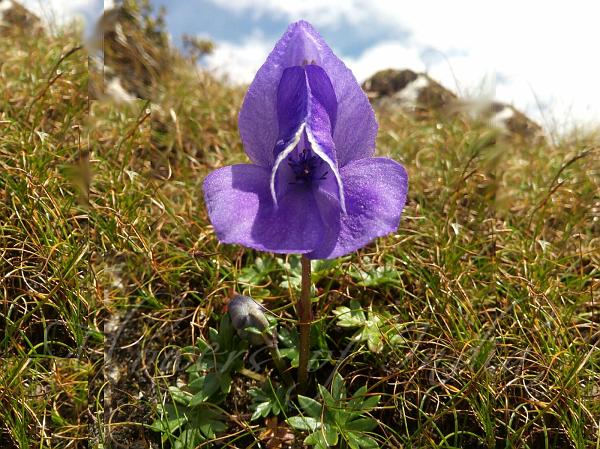|
| East-Himalayan Monkshood |
|

|

|
|
|
|
Photo: |
Botanical name: Aconitum fletcherianum Family: Ranunculaceae (Buttercup family)
East-Himalayan Monkshood is a perennial herb with
rhizome round, branched. Stem is 5-19 cm. Leaves are all basal;
leaf-stalk 2.5-14.5 cm, slender, hairless, base sheathed; leaf blade
round-heart-shaped or kidney-shaped, 1-3 x 2-4 cm, palmately or
pedately 3-5-parted; lobes obovate-wedge-shaped, 2- or 3-lobed;
ultimate lobes ovate or oblong, tip pointed or mucronate. Flowering
stems are 1-4, erect, 6.5-14 cm tall, distally retrorse velvet-hairy;
bracts 2, stalked, similar to leaves but smaller, at distal part of
flower-stalks. Flower occur solitary, at branch-ends. Sepals
blue-purple, hairless or below sparsely velvet-hairy; lower sepals
broadly obovate, or nearly round, about 2 × 2 cm; upper sepal
boat-shaped, shortly beaked, about 3 x 0.9-1.2 cm from base to beak.
Petals about 2 cm, hairless; claw slender; limb about 3 mm; lip very
short, entire or slightly concave; spur narrowly cylindric. Stamens are
distally finely velvet-hairy or hairless; filaments broadly
lanceshaped. Carpels are 6-8, sparsely velvet-hairy. East-Himalayan
Monkshood is found in wet places on slopes, grassy slopes in Eastern
Himalayas, Bhutan and NE India, at altitudes of 4300-5100 m.
Flowering: July-October.
| Identification credit: Magnus Lidén | Photographed in Arunachal Pradesh. |
• Is this flower misidentified? If yes,